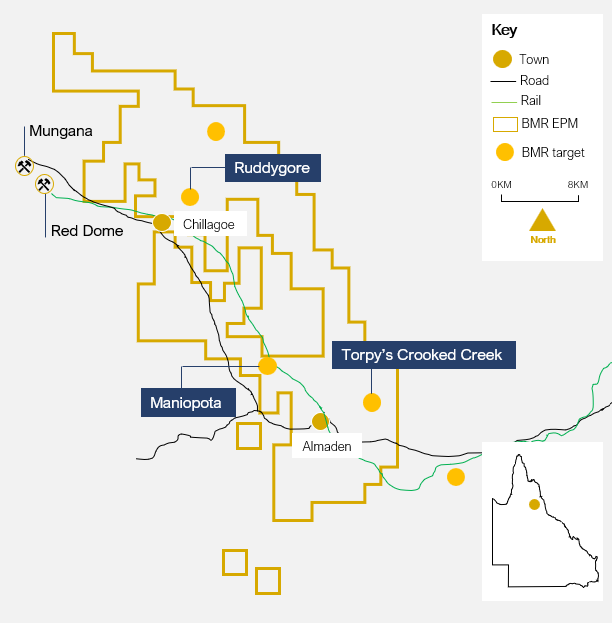Ruddygore Project
The Ruddygore Project is located adjacent to the town of Chillagoe in North Queensland and approximately 150 km west of Cairns. It comprises four granted EPMs and an EPM application covering an area of 556 km2. Historically, Chillagoe was a significant mining and smelting centre that was most active from 1888 to 1927, prior to further substantial production of gold, copper and silver from the Red Dome mine from 1986 to 1997.

Previous Mining
The Ruddygore Mine was mined from 1896 to 1909 by open cut and shaft access to underground. The mine yielded 1,450 tons of copper from 32,750 tons of handpicked ore at an average grade of 3.9% Cu and 56 g/t Ag.
The Maniopota mine is a skarn deposit mined for lead, zinc, and silver. No production records have been found for this site, but it hosts a series of small pits over 1 km strike length.
The Torpy’s Crooked Creek mine operated from 1904 –1914 when production included 6,000 tons of ore yielding 84,000 oz silver and 920 tons of lead at average grades of 15.3% Pb and 435 g/t Ag.
Maniopota heli-borne electromagnetic survey.
In March 2024, Ballymore received a grant for AS$300,000 from the Queensland Government to undertake a semi regional heli-borne electromagnetic (EM) survey over a large portion of the highly prospective Chillagoe Formation rock unit. The survey commenced in late July 2024 and was completed in August and covered the Maniopota prospect. It represents the first EM geophysical assessment of the area in over 50 years.
Throughout the year, Ballymore undertook further modelling and interpretation of the geophysical data returned from the SkyTEM heli-borne EM survey. In addition, ground investigation of various priority targets commenced.
Maniopota exhibits remarkably similar characteristics to numerous major mines in the area including Red Dome, Mungana, Redcap and Victoria to the north, and Mount Garnet to the south.
The SkyTEM helicopter time-domain EM system provides high-resolution conductivity imaging to map accumulations of conductive material such as semi-massive and massive sulphides, with maximum exploration depth and enhanced sensitivity to conductive targets. The addition of this innovative and valuable geophysical dataset in collaboration with geological and geochemical datasets already collected by Ballymore, should allow the development of exciting drill targets in this region.
The Maniopota area hosts extensive historic mine workings and field work has recognised high-grade gold-base metal mineralisation with rock chips reporting up to 22.20% Cu, 31.20% Pb, 13.80% Zn, 1.07 g/t Au and 585 g/t Ag.
Limited historic drilling has reported significant shallow intersections that have not been followed up:
- 14m @ 2.59% Pb, 8.98% Zn, 0.12% Cu & 15.7 g/t Ag (MPRC4: 6 – 20m)
including 8m @ 4.40% Pb, 15.54% Zn, 0.21% Cu & 20.0 g/t Ag (MPRC4: 6 – 14m)
- 3m @ 10.72% Pb, 20.63% Zn & 0.35% Cu (MPRC5: 13 – 16m)
The Maniopota prospect contains classic skarn-hosted mineralisation, similar in style to other deposits and mines in this area, and recent multi-element soil and rock chip sampling completed by Ballymore has identified broad polymetallic anomalies over 6.5km. Maniopota has proven mineralisation of zinc and copper as well as lead and silver. Ballymore has also recognised anomalous geochemical enrichment of bismuth in soil and rock chips as well as Platinum Group Elements (PGEs) including platinum and palladium in soil. Enrichment has also been identified for other critical minerals such as antimony and selenium with moderate enrichment values for indium, tungsten and tin.

